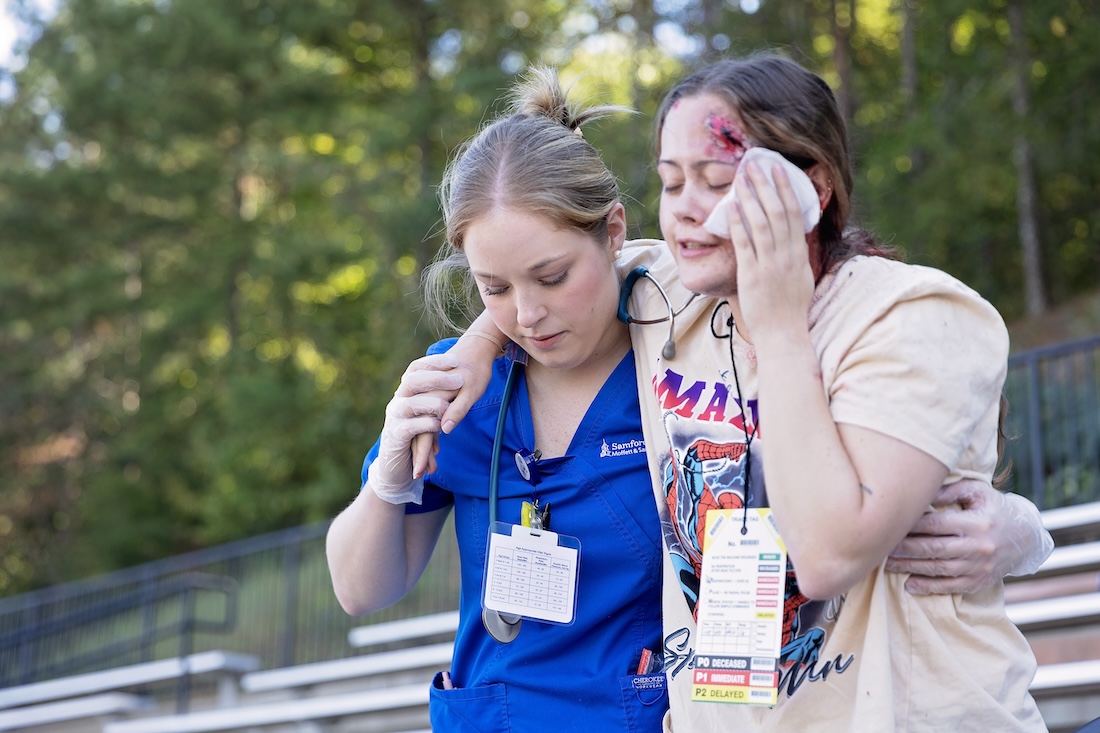
Samford University’s College of Health Sciences transformed the Track and Soccer Complex into a high-stakes emergency zone on Oct. 17, hosting a large-scale disaster simulation that gave students hands-on experience in crisis response. The scenario—a stadium bleacher collapse—was designed to mirror the urgency and unpredictability of a real-world disaster, featuring impalements, crushing trauma, respiratory distress and trampling injuries.
From the start, students were guided and mentored by experienced first responders. Homewood Fire and Rescue coordinated on-site response efforts, providing real-time instruction on emergency command structure, triage procedures and interagency collaboration. Their presence allowed students to learn directly from seasoned emergency medical services and fire personnel, reinforcing critical skills while demonstrating how professional responders lead and support a team during high-pressure situations. Other agencies involved include Jefferson County EMA, Birmingham EMS Management System, Jefferson County Healthcare Coalition and Samford Police.
More than 150 students participated, taking on roles as both victims and responders. Students from four programs—nursing, nutrition and dietetics, social work and pharmacy—worked side by side in a fast-paced, high-stress environment that demanded quick thinking, collaboration and compassion. 34 fifth-semester undergraduate nursing students served as field responders, while 20 social work students worked with medically stable patients through counseling and a family assistance center, providing counseling and support for mental health needs during the emergency crisis.
“This simulation really emphasized cooperation between different professions and showed the importance of teamwork and communication when it comes to saving lives,” said Johnny Jones, a fifth-semester nursing student. “As a future emergency department nurse, this was a valuable experience to help me understand how to respond—and how others in the field respond—during emergency situations.”
A virtual component extended the simulation to online social work students who operated a simulated call center. These students fielded calls from “family members” seeking updates about loved ones, highlighting the essential role of communication and coordination during emergencies.
Jean Roberson, DSW, assistant professor in Samford’s Department of Social Work, called the experience an invaluable learning opportunity for her students.
“Our past research with Master of Social Work students who participate in the Disaster Simulation revealed one of the greatest points of learning was how to practice mental health skills amidst chaos, stress and a lack of structure,” Roberson said. “These elements can only be recreated through a disaster simulation, so we look forward to the experience, knowing the unique benefits it provides to our students.
Jill Pence, EdD, executive director of simulation and professor of nursing, said the simulation gives students opportunities to practice skills outside of a hospital or clinic setting alongside community responders, “while building communication, respect, and awareness of the various roles and responsibilities as well as practicing important, life-saving skills with limited resources.”
By the end of the hour-long exercise, the scene that began in chaos had settled into calm. Students walked away with more than adrenaline. They gained hands-on experience, strengthened interprofessional teamwork and developed a deeper understanding of what it takes to respond effectively in real-world disasters, affirming Samford’s national reputation for its quality of career preparation and student learning opportunities, ranking No.3 and No.7 respectively in The Wall Street Journal/College Pulse for 2026.
